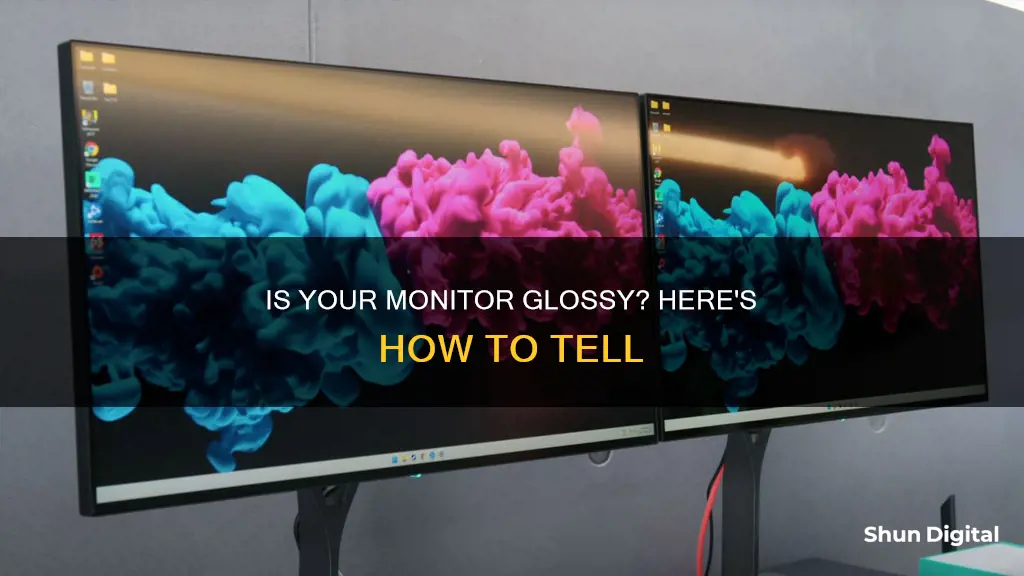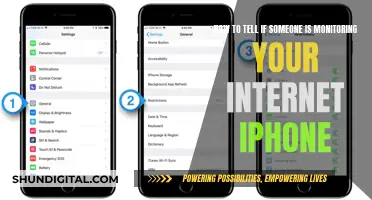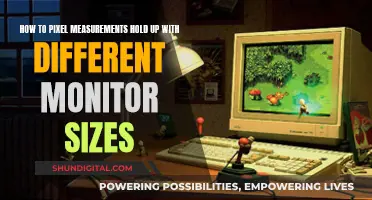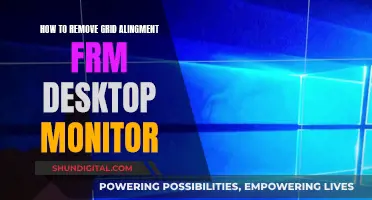
If you're looking to buy a new monitor, it's important to know the difference between a glossy and matte screen. Glossy screens have a reflective finish that makes colours appear brighter and more vivid, but they can also cause glare and reflections that lead to eye strain. On the other hand, matte screens have a finish that reduces reflectivity, making them easier on the eyes and more suitable for use in bright environments. To tell if a monitor is glossy, simply look at the front of the screen when it's turned off; if you see your reflection, it's glossy. Most modern monitors are matte, but if you're looking to buy a glossy screen, you may need to check the model series or contact the manufacturer directly as this information is not always listed in product descriptions.
| Characteristics | Values |
|---|---|
| Reflection | Glossy screens are highly reflective and can show your own reflection like a mirror. Matte screens have less reflectivity. |
| Lighting | Glossy screens reflect light sources in the environment. Matte screens scatter light that hits the monitor. |
| Colours | Glossy screens showcase deeper darks, brighter whites, and richer colours. Matte screens have lower contrast and less vivid colours. |
| Eye strain | Glossy screens can cause eye strain and fatigue due to glare and reflections. Matte screens are easier on the eyes. |
| Smudges and fingerprints | Glossy screens are more prone to smudges and fingerprints. Matte screens are less likely to show fingerprints. |
| Dust | Glossy screens attract more dust. Matte screens are less likely to show dust. |
| Usage | Glossy screens are better for multimedia, such as viewing photos or playing games and videos. Matte screens are better for offices, classrooms, or outdoor use. |
What You'll Learn

Look for your reflection: if you see yourself, it's glossy
The easiest way to determine whether a monitor is glossy or matte is to look at the screen when it is powered off. If you see your reflection, the screen is glossy. If you see a plain shade, the screen is matte.
Glossy screens have a reflective finish, showcasing deeper blacks, brighter whites, and more vivid colours. However, they can cause eye strain due to glare and reflections. Light sources in your environment, such as desk lamps, can reflect onto the screen, causing unwanted distractions. Additionally, glossy screens are more prone to smudges and fingerprints, requiring more maintenance to keep clean.
Matte screens, on the other hand, have less reflectivity and are easier on the eyes. They are better suited for environments with bright lighting, such as offices, classrooms, or outdoor use. While matte screens may not have the same vibrant image quality as glossy screens, they are more practical and reduce eye strain.
It's worth noting that most modern monitors are glossy, and you may need to specifically look for a matte finish if that is your preference. Additionally, glossy screens are typically found on consumer-line laptop models, while matte screens are more common in business-line laptops.
Monitoring Motherboard Temps: ASUS Strix Guide
You may want to see also

Glossy screens showcase deeper blacks, brighter whites, and richer colours
Glossy screens have a reflective finish that showcases deeper blacks, brighter whites, and richer colours. This is due to their high degree of transparency, which allows almost all of the display's light output to show through, resulting in a very vivid image.
In certain light environments, glossy displays provide better colour intensity and contrast ratios than matte displays. In controlled environments, such as darkened rooms, or rooms where all light sources are diffused, glossy displays create more saturated colours, deeper blacks, and brighter whites. This is why supporters of glossy screens consider them more appropriate for viewing photographs and watching films.
However, the primary disadvantage of glossy screens is their tendency to reflect any external light, often resulting in an undesirable glare. This can be distracting to users, especially in an office environment, where the position of lights and windows is fixed, creating unavoidable reflections.
Glossy screens are ideal for graphic design, multimedia use, viewing photos, and playing games and videos.
Monitoring Internet Usage: Boost Mobile's Data Insights
You may want to see also

Glossy screens reflect light sources in your environment
Glossy screens are made of reflective glass or polymers, which allow for a very vivid image. They showcase deeper darks, brighter whites, and richer colours than their matte counterparts. However, this comes at a cost. Glossy screens reflect light sources in your environment, such as room lights and windows, causing glare and reflections. This can be distracting and lead to eye strain and fatigue.
The impact of light reflection on glossy screens is influenced by the placement of light sources relative to the screen and the viewer. Overhead lights, for example, may not cause as much glare as lights positioned behind the viewer. Additionally, the light source's angle and intensity can affect the degree of reflection.
To address the issue of light reflection, modern glossy screens often have anti-glare treatments using materials like magnesium fluoride. These treatments aim to reduce the amount of light reflecting off the screen, making it easier to view the display.
If you're considering a glossy screen, it's important to carefully evaluate your environment and lighting conditions. Ensure that light sources are positioned in a way that minimises reflections on the screen. By controlling the lighting in your environment, you can potentially enjoy the enhanced image quality offered by glossy screens without the negative impact of excessive glare.
Enlarging Font Size on Your Monitor: A Simple Guide to Bigger Text
You may want to see also

Matte screens are better for bright locations like offices
Matte screens are the best option for bright locations like offices. Matte screens have less reflectivity and are easier on the eyes, making them ideal for workplaces with bright lighting or windows. They reduce eye strain and fatigue by minimising glare and reflections, creating a more comfortable viewing experience.
In contrast, glossy screens can cause issues in well-lit environments. Their highly reflective surfaces may reflect overhead lights or windows, resulting in unwanted glare and a distracting view of your own reflection. With a glossy screen, you might find yourself constantly adjusting desk lamps and curtains to reduce the glare, which can be frustrating and time-consuming.
Matte screens are also more practical in terms of maintenance. Glossy screens are known to attract fingerprints and dust, requiring frequent cleaning to keep them looking their best. Matte screens, on the other hand, are less prone to showing fingerprints and smudges, making them a more low-maintenance option.
While glossy screens offer richer colours and deeper blacks, the benefits of matte screens in bright locations like offices outweigh this advantage. Matte screens allow you to work without worrying about light sources affecting your screen visibility. You can open the curtains to let natural light in without sacrificing screen clarity.
Additionally, matte screens are the standard choice for business laptops and monitors. Manufacturers often reserve glossy screens for consumer-line laptop models, while matte screens are typically found in business-line laptops. This is because matte screens are better suited to office environments, where reduced glare and eye strain are prioritised over vibrant colours.
Overall, if you work in a bright location like an office, a matte screen is the best choice for your monitor. It will provide a more comfortable and practical viewing experience, allowing you to focus on your work without the distractions and maintenance hassles of a glossy screen.
Monitoring Bandwidth Usage: Top Programs to Watch Your Network
You may want to see also

Matte screens are best for reducing eye strain
If you're looking to reduce eye strain, matte screens are the way to go. Matte screens have a less reflective finish, making them easier on the eyes and ideal for use in bright environments like offices, classrooms, or outdoors. On the other hand, glossy screens offer brighter and more vivid colors but tend to reflect light more, which can cause eye strain.
Matte screens are particularly beneficial if you work with printed pages and a computer screen simultaneously. By reducing glare and reflection, matte screens help minimize eye strain associated with constantly shifting your focus between the two. Additionally, if you're a contact lens wearer, matte screens can be a better option as contact lenses can become dry and uncomfortable during extended screen time.
The reduced reflectivity of matte screens also comes into play when considering your lighting setup. With a matte screen, you have more flexibility to position your screen near windows without worrying about excessive glare. This can help you take advantage of natural light and create a more comfortable working environment.
Another advantage of matte screens is their compatibility with anti-glare filters. If you find yourself needing additional glare reduction, you can easily apply an anti-glare filter to your matte screen without worrying about any negative impact on image quality.
It's worth noting that the choice between a glossy and matte screen ultimately comes down to personal preference. However, if you're prioritizing eye strain reduction, the characteristics of matte screens make them a more suitable option.
Removing Crayon Marks from LCD Monitors
You may want to see also
Frequently asked questions
The easiest way to check is to look at the front of the screen when it is powered off. If you see your reflection, the screen is glossy. If you only see a plain shade, the screen is matte.
Glossy screens cause eye strain due to glare and reflections. They also attract dust and smudges and are therefore harder to keep clean.
Glossy screens showcase deeper darks, brighter whites, and richer colours than matte screens. They are therefore better suited to displaying photos or playing games and videos.







